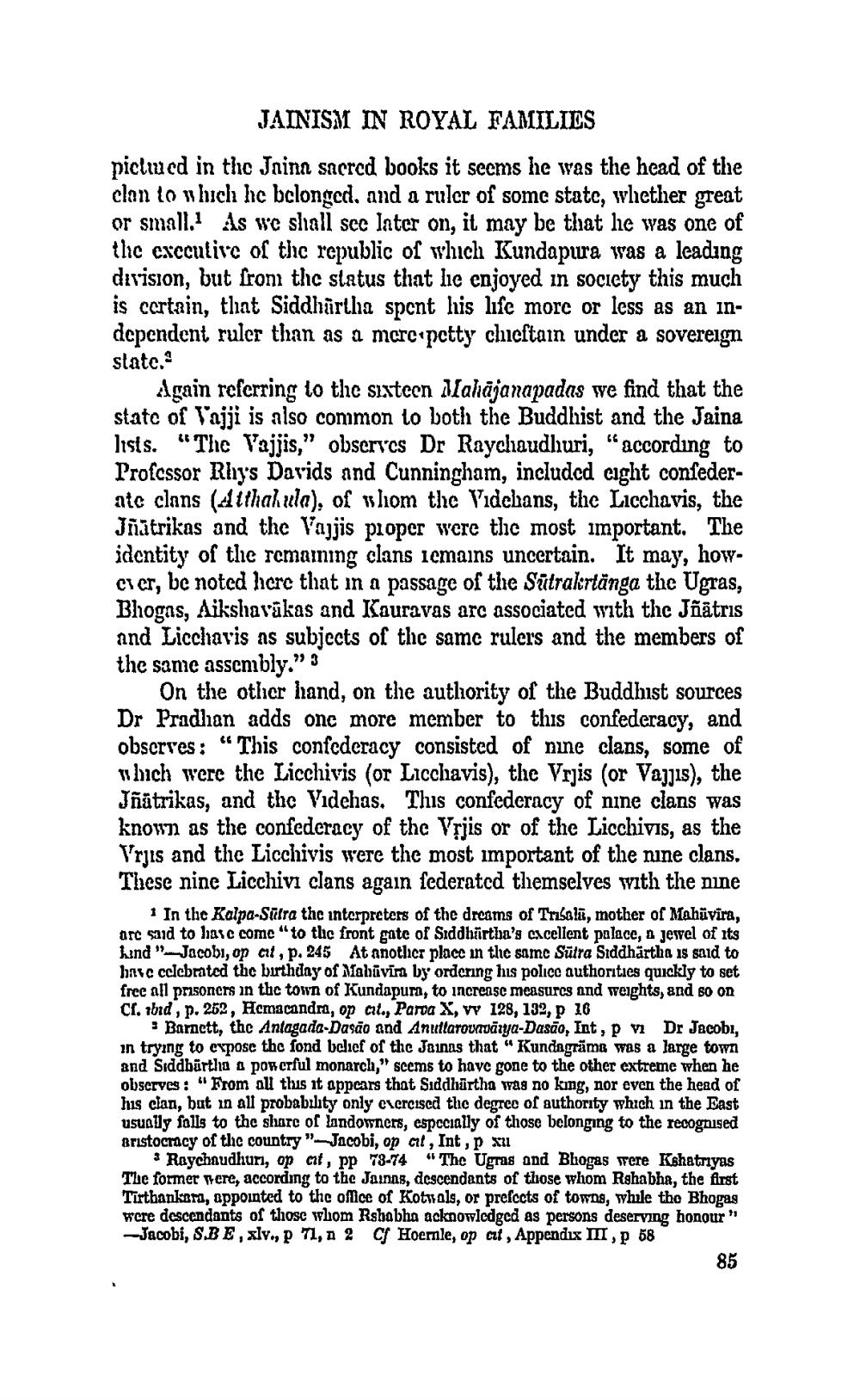________________ JAINISM IN ROYAL FAMILIES picluucd in the Joinn sacred books it seems he was the head of the clan to which he bclongcd, and a ruler of some state, whether great or small. As we shall sce later on, it may be that he was one of the executive of the republic of which Kundapura was a leading division, but from the status that lie enjoyed in society this much is certain, tliat Siddhartha spent his life more or less as an independent ruler than as a merc petty chieftain under a sovereign state. Again referring to the sixteen Mahajanapadas we find that the state of Vajji is also common to both the Buddhist and the Jaina lists. "The Vajjis," obscrvcs Dr Raychaudhuri, "according to Professor Rhys Davids and Cunningham, included cight confederate clans (Atthalula), of whom the Videians, the Licchavis, the Jnatrikas and the Vajjis proper were thic most important. The identity of the remaining clans icmains uncertain. It may, howcier, be noted here that in a passage of the Sitrakrtanga the Ugras, Bhogas, Aikshavakas and Kauravas arc associated with the Jnatris and Licchavis as subjects of the same rulers and the members of the same assembly." 3 On the other hand, on the autliority of the Buddhist sources Dr Pradlian adds one more member to this confederacy, and obscrves: "This confederacy consisted of mine clans, some of which were the Licchivis (or Licchavis), the Vrjis (or Vajjis), the Jnatrikas, and the Videlas. This confederacy of nine clans was known as the confederacy of the Vyjis or of the Licchivis, as the Vrjis and the Licchivis were the most important of the nine clans. These ninc Licchivi clans again federated themselves with the nine 1 In the Kalna-Satra the interpreters of the dreams of Tribalit, mother of Mahavira, are said to have come "to the front gate of Siddhartha's excellent palace, a jewel of its hind " Jacobi, op cit, p. 245 At another place in the same Sutra Siddharths is said to hinte celebrated the birthdny of Nabavira by ordering his police authorities quickly to set free all prisoners in thc town of Kundapur, to increase measures and weights, and so on Cl. tord, p. 252, Hemacandra, op al., Parva X, v 128, 132, 26 Barnett, the Antagada-Dasao and Anutarourtuarya-Dasao, Int, P v Dr Jacobu, in trying to expose the fond belief of the Jains that " Kundngrama was a large town ind Siddhartha a powerful monarch," scems to have gone to the other extreme when he obscrves: "From all this it appears that Siddhurtha wag no king, nor even the head of his clan, but in all probability only cxcrcised the degree of authority which in the East usually falls to the suure of landowners, especially of those belonging to the recognised Aristocracy of the country"-Jacobi, on al, Int , p XXL * Raychaudhuri, op af, pp 73-74 "The Ugras ond Blogas were Kshatriyas The former Tere, according to the Jains, descendants of those whom Rshabha, the first Tirtbankam, appointed to the omce of Kotisals, or prefects of towns, while the Bhogas were descendants of those whom Rshabha acknowledged as persons deserving honour" -Jacobi, S.BE , xlv., 71, n 2 Cf Hocrnle, op at , Appendix III, 58 85




